Have you ever been leafing through the pages of a popular magazine, when you come across an exceptional photograph that vibrates with appeal or dramatic presentation? Maybe it’s a shot of a pretty young girl chatting with her dolls at a tea party, or a close-up of the weather beaten face of an old fisherman, or a beautiful young lady wearing the latest sportswear outfit.
You may have wondered at the luck of the photographer who found their model in just the right pose, with just the right expression, and exactly the right lighting when they reached for the camera. If you have, you’re 100% wrong, because good model pictures aren’t made that way. Once in a while a lucky picture may happen, but the photographer creates most of the good model shots you see down to every detail. Yes, even the expression of the subjects face is the photographer’s handiwork. To make good model pictures consistently you have to be a combination of photographer, stage manager, director, and psychologist, all in one.
Posing Babies
A nine-month-old baby is the best and the worst possible model for any photographer to deal with. A baby can be the worst because they are almost entirely out of control and because you will never know what they will do next. Babies can be the best because they are completely themselves in front of a camera. They don’t care whether their picture is taken or not.
The first thing to do in photographing a baby is to find a playpen, a highchair, or some corral that restricts your young model’s range of activities. Place this restrictive device in front of a clean, simple background in such a position that the subject may be lit from two or more directions without the danger of throwing too strong of shadows across the image. Then choose the camera position, focus on the point where the baby will be and set the shutter for at least 1/125 of a second. When everything is ready, put the model in the setting and hope for the best.
Noisemakers can help
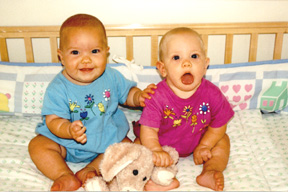
Two babies can be double trouble!
Don’t have a crowd around your set and, if you can do it diplomatically, keep the baby’s mother out of sight. Of course, you will have a supply of toys and other objects to attract and keep the child’s attention. One thing is for sure, you will get good expressions. They may be joy, rage, or despair, but they will all genuine and all good picture material.
Noisemakers can help get the baby’s attention. Sometimes a whistle, the tapping on a glass surface, or funny baby sounds coming from the photographer will help get the baby to look at the camera.
Posing Children As the baby grows older he or she will become increasingly easier to control. By the time they reach school age, they will even try to cooperate with the photographer. But at the same time they will begin to care that there picture is being taken and will want the images to be good pictures. The older the model the more they will care. Even so, it is still fairly easy to get natural expressions because all children are born actors. They live in a world of make-believe and in the magic of “let’s pretend” you will learn the secret of good children pictures.
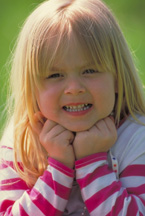
Use pretend games
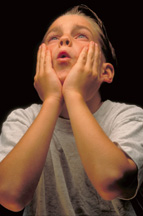
Look for natural expressions
The expressions you motivate through “pretend” games can be as genuine as any real situation. You must enter into the game as thoroughly as the children do. The least hint of condescension in your voice, the slightest flicker of amusement on your face, and they will know that you are not sincere. If this happens the action-play comes to an end and you will have an expressionless model in front of your lens.
Posing Adults
By the time the child reaches teen-age they care a great deal about their appearance in a picture. They will no longer be capable of natural acting or playing make-believe. Now is the time when the photographer must become something of a psychologist.
Call it vanity; call it self-consciousness, inferiority complex, or whatever, the fact remains that most adults do not look natural in front of the camera. Very occasionally we run into someone with that priceless quality called ‘the look and poise’. But learning to poise is an acquired characteristic. Often it is the result of special training, as in the case of the actor or the professional model. The great majority of us can hope to look natural in front of the lens only with considerable help from the photographer.
The sad part of it is that amateur photographers, even the advanced ones whose skills parallels that of the professional, seldom extend this help to their models. First of all, the models cannot have any confidence in themselves unless they have confidence in you the photographer. You must display perfect self-confidence at all times. Maybe you are worried about some question of exposure, perhaps you are not sure that the lighting is just right, etc. The models should never suspect your qualms. As far as they are concerned you are in complete control of the situation.
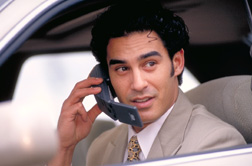
Take control – be the director
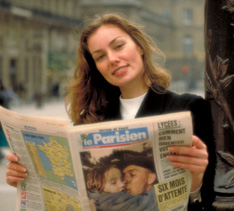
Instill confidence
Beyond this you can instill confidence in your subjects by a little thoughtful claptrap. It’s an old trick of the professional to start out by making several exposures without film. After each such “exposure,” the photographer will act pleased and compliment the model on their co operation and look. By the time the cameraman is ready to take the actual pictures the model has loosened up and the self-consciousness gives way to animation and interest.
Posing
Even though models are posed, the pose must never look obvious in the final picture. Expressions must be spontaneous even though they are in response to planned action. A trained actor counterfeits genuine emotions, but with the untrained subject you must make it happen and he ready to catch any fleeting response. The photographer learns how to create a situation or an atmosphere, which evokes natural expressions.
Probably the most successful method is to engineer what the playwright calls business. When an actor is on the stage and has no lines to speak for the moment, he or she must do something. If they were to stand like a statue, they would destroy the illusion of reality on which the play depends. So the scriptwriter writes into the script some small action or business to keep the actor occupied. This illusion of reality in a picture can be maintained in the same way.
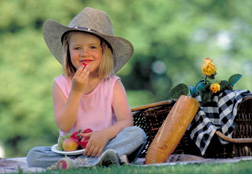
Use props and make business
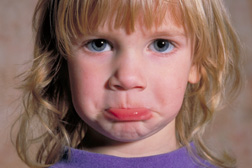
Focus on the eyes
If you give your model something to do, it gives the picture a reason for being, the picture tells a story. On the stage, business is carried out with the aid of props. In photography the same thing holds true. Give your model something to work with and a good picture is likely to be made. A prop may be anything from a kitten for a child or single rose for a young lady, providing it is in keeping with the character of your subject. The lean brown athlete looks more natural on the tennis court than out picking lilacs. Even when making extreme close-ups it is good practice to provide the subject with something to engross their attention. Whether the prop shows or not, it serves the purpose of creating a natural and easy expression.
10 Quick Posing Tips
Focus on your model eyes; they are the windows to their soul
Take command of every situation, you are the director
Setup your camera and lighting before you introduce your model
Always plan your work and work your plan
Have and project self confidence
Instill confidence in your subjects
When ever possible use props with your models
Develop some business for your models to do
Keep your lighting simple and your direction clear-cut
Look for natural and easy expressions
by Brian Ratty
Text and pictures © 2000
Some photography by Diamar Portfolios

Leave a Reply